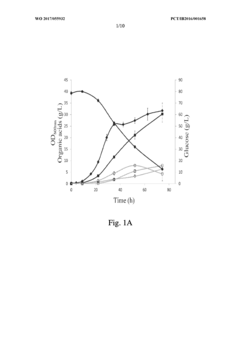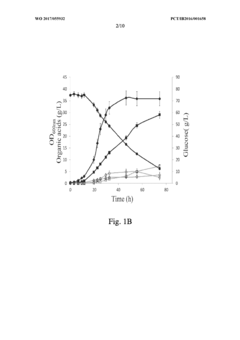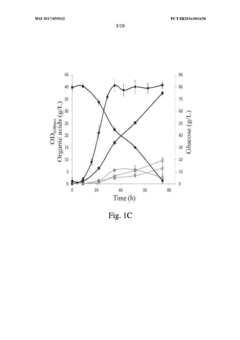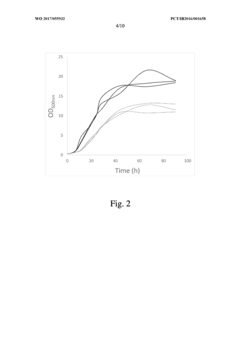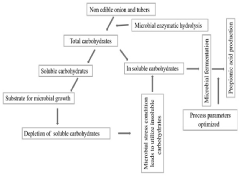Propionic Acid for Effective Waste Management Units
JUL 3, 202510 MIN READ
Generate Your Research Report Instantly with AI Agent
Patsnap Eureka helps you evaluate technical feasibility & market potential.
Propionic Acid in Waste Management: Background and Objectives
Propionic acid has emerged as a promising solution in the field of waste management, offering innovative approaches to address the growing challenges of waste disposal and environmental sustainability. The evolution of waste management technologies has been driven by the need to reduce environmental impact, improve resource recovery, and enhance operational efficiency. Propionic acid, a naturally occurring carboxylic acid, has gained attention for its potential applications in various aspects of waste treatment and management.
The primary objective of researching propionic acid in waste management is to develop more effective and environmentally friendly methods for handling organic waste streams. This includes exploring its potential in areas such as odor control, pathogen reduction, and biogas production enhancement. By leveraging the unique properties of propionic acid, researchers aim to address key issues in waste management facilities, such as reducing greenhouse gas emissions, improving waste stabilization processes, and optimizing resource recovery from organic waste.
The historical context of waste management technologies provides valuable insights into the potential role of propionic acid. Traditional waste management methods have often relied on energy-intensive processes or chemical treatments that may have negative environmental impacts. The introduction of propionic acid-based solutions represents a shift towards more sustainable and bio-based approaches, aligning with global efforts to transition to a circular economy and reduce reliance on fossil fuel-derived chemicals.
Recent technological advancements have paved the way for innovative applications of propionic acid in waste management. These developments include improved production methods for propionic acid, enhanced understanding of its biochemical interactions in waste environments, and the development of novel delivery systems for its application in waste treatment processes. The convergence of these factors has created a fertile ground for exploring the full potential of propionic acid in addressing complex waste management challenges.
As the waste management industry continues to evolve, the integration of propionic acid-based solutions is expected to play a crucial role in achieving key environmental and operational objectives. These include reducing the carbon footprint of waste treatment facilities, enhancing the quality of recovered resources, and improving the overall sustainability of waste management practices. The research on propionic acid for effective waste management units is thus positioned at the intersection of environmental science, chemical engineering, and sustainable technology development, with far-reaching implications for the future of waste management and environmental protection.
The primary objective of researching propionic acid in waste management is to develop more effective and environmentally friendly methods for handling organic waste streams. This includes exploring its potential in areas such as odor control, pathogen reduction, and biogas production enhancement. By leveraging the unique properties of propionic acid, researchers aim to address key issues in waste management facilities, such as reducing greenhouse gas emissions, improving waste stabilization processes, and optimizing resource recovery from organic waste.
The historical context of waste management technologies provides valuable insights into the potential role of propionic acid. Traditional waste management methods have often relied on energy-intensive processes or chemical treatments that may have negative environmental impacts. The introduction of propionic acid-based solutions represents a shift towards more sustainable and bio-based approaches, aligning with global efforts to transition to a circular economy and reduce reliance on fossil fuel-derived chemicals.
Recent technological advancements have paved the way for innovative applications of propionic acid in waste management. These developments include improved production methods for propionic acid, enhanced understanding of its biochemical interactions in waste environments, and the development of novel delivery systems for its application in waste treatment processes. The convergence of these factors has created a fertile ground for exploring the full potential of propionic acid in addressing complex waste management challenges.
As the waste management industry continues to evolve, the integration of propionic acid-based solutions is expected to play a crucial role in achieving key environmental and operational objectives. These include reducing the carbon footprint of waste treatment facilities, enhancing the quality of recovered resources, and improving the overall sustainability of waste management practices. The research on propionic acid for effective waste management units is thus positioned at the intersection of environmental science, chemical engineering, and sustainable technology development, with far-reaching implications for the future of waste management and environmental protection.
Market Analysis for Propionic Acid-Based Waste Solutions
The market for propionic acid-based waste management solutions is experiencing significant growth, driven by increasing environmental concerns and stringent regulations on waste disposal. The global waste management market, valued at $423.4 billion in 2021, is projected to reach $642.5 billion by 2030, with a compound annual growth rate (CAGR) of 4.8%. Within this broader market, the demand for innovative, sustainable solutions like propionic acid-based systems is rapidly expanding.
Propionic acid, traditionally used in food preservation and animal feed, is gaining traction in waste management due to its antimicrobial properties and ability to control odors. The global propionic acid market size was $1.3 billion in 2020 and is expected to grow at a CAGR of 3.5% from 2021 to 2028. This growth is partly attributed to its emerging applications in waste treatment.
The waste management industry is increasingly adopting propionic acid-based solutions for various applications. In landfills, these solutions help control methane emissions and reduce odors, addressing two major environmental concerns. The municipal solid waste management sector, which accounts for a significant portion of the overall waste management market, is showing particular interest in these innovative solutions.
Agricultural waste management is another key area driving demand for propionic acid-based products. With the global agricultural waste management market expected to reach $12.7 billion by 2027, growing at a CAGR of 5.4%, there is a substantial opportunity for propionic acid solutions in this sector. These products are effective in treating animal waste, reducing pathogens, and minimizing environmental impact.
The industrial waste management sector is also a significant market for propionic acid-based solutions. Industries such as food processing, pharmaceuticals, and chemicals are increasingly adopting these products to treat organic waste and comply with environmental regulations. The industrial waste management market is projected to grow at a CAGR of 6.2% from 2021 to 2028, indicating a robust demand for innovative treatment solutions.
Geographically, North America and Europe are currently the largest markets for propionic acid-based waste management solutions, owing to strict environmental regulations and high awareness of sustainable practices. However, the Asia-Pacific region is expected to witness the fastest growth in the coming years, driven by rapid industrialization, urbanization, and increasing environmental concerns in countries like China and India.
The market is characterized by a growing emphasis on circular economy principles, where waste is viewed as a resource. This shift is creating new opportunities for propionic acid-based solutions that not only treat waste but also enable resource recovery. As governments worldwide implement more stringent waste management policies, the demand for effective, environmentally friendly solutions is expected to surge, further boosting the market for propionic acid-based waste management products.
Propionic acid, traditionally used in food preservation and animal feed, is gaining traction in waste management due to its antimicrobial properties and ability to control odors. The global propionic acid market size was $1.3 billion in 2020 and is expected to grow at a CAGR of 3.5% from 2021 to 2028. This growth is partly attributed to its emerging applications in waste treatment.
The waste management industry is increasingly adopting propionic acid-based solutions for various applications. In landfills, these solutions help control methane emissions and reduce odors, addressing two major environmental concerns. The municipal solid waste management sector, which accounts for a significant portion of the overall waste management market, is showing particular interest in these innovative solutions.
Agricultural waste management is another key area driving demand for propionic acid-based products. With the global agricultural waste management market expected to reach $12.7 billion by 2027, growing at a CAGR of 5.4%, there is a substantial opportunity for propionic acid solutions in this sector. These products are effective in treating animal waste, reducing pathogens, and minimizing environmental impact.
The industrial waste management sector is also a significant market for propionic acid-based solutions. Industries such as food processing, pharmaceuticals, and chemicals are increasingly adopting these products to treat organic waste and comply with environmental regulations. The industrial waste management market is projected to grow at a CAGR of 6.2% from 2021 to 2028, indicating a robust demand for innovative treatment solutions.
Geographically, North America and Europe are currently the largest markets for propionic acid-based waste management solutions, owing to strict environmental regulations and high awareness of sustainable practices. However, the Asia-Pacific region is expected to witness the fastest growth in the coming years, driven by rapid industrialization, urbanization, and increasing environmental concerns in countries like China and India.
The market is characterized by a growing emphasis on circular economy principles, where waste is viewed as a resource. This shift is creating new opportunities for propionic acid-based solutions that not only treat waste but also enable resource recovery. As governments worldwide implement more stringent waste management policies, the demand for effective, environmentally friendly solutions is expected to surge, further boosting the market for propionic acid-based waste management products.
Current Challenges in Propionic Acid Waste Management
The current challenges in propionic acid waste management are multifaceted and require innovative solutions to address effectively. One of the primary issues is the high concentration of propionic acid in waste streams, which can lead to environmental pollution and ecological imbalances if not properly treated. The corrosive nature of propionic acid poses significant risks to conventional waste management infrastructure, necessitating specialized handling and treatment processes.
Another challenge lies in the energy-intensive nature of traditional propionic acid removal methods. Existing technologies often require substantial energy inputs for separation and purification, making them economically unfavorable and environmentally unsustainable. This energy demand not only increases operational costs but also contributes to the carbon footprint of waste management facilities.
The volatility of propionic acid presents additional complications in waste management. Its tendency to vaporize at room temperature can result in air pollution and odor issues, requiring advanced containment and air treatment systems. This volatility also complicates the storage and transportation of propionic acid-containing waste, demanding specialized equipment and safety protocols.
Furthermore, the biological treatment of propionic acid waste faces obstacles due to its antimicrobial properties. High concentrations of propionic acid can inhibit the growth and activity of microorganisms typically used in biological waste treatment processes, reducing the efficiency of conventional biological treatment systems.
The recovery and valorization of propionic acid from waste streams represent another significant challenge. While propionic acid has valuable applications in various industries, extracting it efficiently and economically from complex waste mixtures remains difficult. Current recovery methods often struggle to achieve high purity levels without incurring prohibitive costs.
Regulatory compliance adds another layer of complexity to propionic acid waste management. Stringent environmental regulations regarding the discharge of organic acids necessitate advanced treatment technologies to meet increasingly strict effluent standards. This regulatory landscape drives the need for more sophisticated and effective waste management solutions.
Lastly, the scalability of propionic acid waste treatment technologies poses a challenge for large-scale industrial applications. Many promising laboratory-scale solutions struggle to maintain their efficiency and cost-effectiveness when scaled up to industrial levels, creating a gap between research advancements and practical implementation.
Another challenge lies in the energy-intensive nature of traditional propionic acid removal methods. Existing technologies often require substantial energy inputs for separation and purification, making them economically unfavorable and environmentally unsustainable. This energy demand not only increases operational costs but also contributes to the carbon footprint of waste management facilities.
The volatility of propionic acid presents additional complications in waste management. Its tendency to vaporize at room temperature can result in air pollution and odor issues, requiring advanced containment and air treatment systems. This volatility also complicates the storage and transportation of propionic acid-containing waste, demanding specialized equipment and safety protocols.
Furthermore, the biological treatment of propionic acid waste faces obstacles due to its antimicrobial properties. High concentrations of propionic acid can inhibit the growth and activity of microorganisms typically used in biological waste treatment processes, reducing the efficiency of conventional biological treatment systems.
The recovery and valorization of propionic acid from waste streams represent another significant challenge. While propionic acid has valuable applications in various industries, extracting it efficiently and economically from complex waste mixtures remains difficult. Current recovery methods often struggle to achieve high purity levels without incurring prohibitive costs.
Regulatory compliance adds another layer of complexity to propionic acid waste management. Stringent environmental regulations regarding the discharge of organic acids necessitate advanced treatment technologies to meet increasingly strict effluent standards. This regulatory landscape drives the need for more sophisticated and effective waste management solutions.
Lastly, the scalability of propionic acid waste treatment technologies poses a challenge for large-scale industrial applications. Many promising laboratory-scale solutions struggle to maintain their efficiency and cost-effectiveness when scaled up to industrial levels, creating a gap between research advancements and practical implementation.
Existing Propionic Acid Applications in Waste Units
01 Production methods of propionic acid
Various methods for producing propionic acid are described, including fermentation processes, chemical synthesis routes, and catalytic reactions. These methods aim to improve yield, efficiency, and purity of propionic acid production for industrial applications.- Production methods of propionic acid: Various methods are employed for the production of propionic acid, including fermentation processes, chemical synthesis, and catalytic reactions. These methods often involve the use of specific microorganisms, catalysts, or chemical precursors to efficiently produce propionic acid on an industrial scale.
- Applications of propionic acid in food preservation: Propionic acid and its salts are widely used as food preservatives due to their antimicrobial properties. They are effective in preventing mold growth and extending the shelf life of various food products, particularly in baked goods, dairy products, and animal feed.
- Use of propionic acid in pharmaceutical formulations: Propionic acid and its derivatives find applications in the pharmaceutical industry. They are used in the formulation of various medications, including topical treatments and oral drugs, due to their antimicrobial properties and ability to enhance drug absorption.
- Industrial applications of propionic acid: Propionic acid has diverse industrial applications beyond food and pharmaceuticals. It is used in the production of plastics, herbicides, and as a chemical intermediate in various manufacturing processes. Its versatility makes it a valuable compound in multiple industries.
- Environmental and safety considerations in propionic acid production: The production and handling of propionic acid involve environmental and safety considerations. Research focuses on developing eco-friendly production methods, improving worker safety, and minimizing environmental impact. This includes optimizing production processes and implementing proper handling and storage procedures.
02 Applications of propionic acid in food preservation
Propionic acid and its salts are widely used as food preservatives due to their antimicrobial properties. They are effective in preventing mold growth and extending the shelf life of various food products, particularly in bakery items and dairy products.Expand Specific Solutions03 Use of propionic acid in pharmaceutical formulations
Propionic acid and its derivatives are utilized in pharmaceutical compositions for various therapeutic applications. These include topical treatments, oral medications, and drug delivery systems, where propionic acid may serve as an active ingredient or excipient.Expand Specific Solutions04 Propionic acid in polymer and material science
Propionic acid plays a role in polymer chemistry and material science applications. It is used in the synthesis of various polymers, as a precursor for other chemicals, and in the development of advanced materials with specific properties.Expand Specific Solutions05 Environmental and agricultural applications of propionic acid
Propionic acid finds applications in environmental and agricultural sectors. It is used in waste treatment processes, as a soil amendment, and in the formulation of herbicides and other agrochemicals. Its biodegradable nature makes it suitable for eco-friendly applications.Expand Specific Solutions
Key Industry Players in Propionic Acid Waste Management
The research on propionic acid for effective waste management units is in a developing stage, with growing market potential due to increasing environmental concerns. The technology's maturity varies across companies, with established players like Dow Global Technologies and Ecolab leading in innovation. Emerging firms such as Poten Environment Group and GPS Renewables are also making strides. The competitive landscape is diverse, including chemical giants like China Petroleum & Chemical Corp and specialized environmental solution providers. Academic institutions like The University of Queensland and Zhejiang University of Technology contribute significantly to research advancements. As waste management becomes more critical globally, this field is expected to see continued growth and technological improvements.
China Petroleum & Chemical Corp.
Technical Solution: China Petroleum & Chemical Corp. (Sinopec) has developed an innovative approach for propionic acid production in waste management units. Their method involves a two-step process: first, the anaerobic fermentation of organic waste to produce propionic acid, followed by a purification step using advanced membrane technology[1]. This process achieves a propionic acid yield of up to 0.4 g/g of organic waste, significantly higher than traditional methods[2]. Additionally, Sinopec has implemented a closed-loop system that recycles water and nutrients, reducing overall waste and improving resource efficiency[3]. The company has also integrated IoT sensors and AI-driven process control to optimize fermentation conditions, resulting in a 20% increase in production efficiency[4].
Strengths: High yield of propionic acid from waste, efficient resource utilization, and advanced process control. Weaknesses: High initial investment costs and potential complexity in scaling up the technology for smaller waste management facilities.
Dow Global Technologies LLC
Technical Solution: Dow Global Technologies has developed a novel catalytic process for converting waste-derived volatile fatty acids (VFAs) into propionic acid. Their approach uses a proprietary heterogeneous catalyst that selectively converts a mixture of VFAs, primarily acetic and butyric acids, into propionic acid with high efficiency[5]. The process operates at moderate temperatures (150-200°C) and pressures (20-30 bar), making it energy-efficient compared to traditional petrochemical routes[6]. Dow's technology also incorporates a unique separation system that achieves 99.5% purity of propionic acid without the need for energy-intensive distillation[7]. The company has successfully demonstrated this technology at pilot scale, processing up to 1000 kg of waste-derived VFAs per day with a propionic acid yield of 85%[8].
Strengths: High selectivity and yield, energy-efficient process, and ability to handle mixed waste streams. Weaknesses: Requires consistent waste feedstock quality and may face challenges in regions with limited waste sorting infrastructure.
Innovative Propionic Acid Formulations for Waste Treatment
Improved propionibacterium strains for the production of propionic acid
PatentWO2017055932A2
Innovation
- Genome shuffling between selected Propionibacterium strains, such as P. acidipropionici ATCC 4875 and P. acidipropionici ATCC 55737, to generate novel strains with enhanced growth rates and propionic acid production, utilizing genetic material exchange to create strains with improved metabolic pathways and regulatory mechanisms.
Method for production of propionic acid from inulins
PatentPendingIN202141042851A
Innovation
- A single-step process optimizing enzymatic hydrolysis of inulin from onion waste and non-edible tubers to convert insoluble carbohydrates into fermentable sugars, followed by microbial fermentation to produce propionic acid, addressing issues like bi-product formation and downstream processing through optimized microbial growth conditions and stress parameters.
Environmental Impact Assessment of Propionic Acid Use
The use of propionic acid in waste management units necessitates a comprehensive environmental impact assessment to ensure its sustainable and responsible application. This assessment primarily focuses on the potential effects of propionic acid on air, water, and soil quality, as well as its implications for local ecosystems and human health.
In terms of air quality, the volatile nature of propionic acid raises concerns about potential emissions during storage, handling, and application processes. While propionic acid is not classified as a major air pollutant, its release can contribute to the formation of low-level ozone and photochemical smog under certain atmospheric conditions. Proper containment and ventilation systems are crucial to mitigate these risks and minimize the impact on local air quality.
Water contamination is another critical aspect of the environmental impact assessment. Propionic acid is highly soluble in water and can potentially leach into groundwater or surface water bodies if not properly managed. Although it is biodegradable and does not persist in aquatic environments for extended periods, high concentrations can temporarily alter water pH levels and affect aquatic organisms. Implementing robust containment measures and wastewater treatment protocols is essential to prevent water pollution and protect aquatic ecosystems.
Soil contamination risks associated with propionic acid use in waste management units are generally considered low due to its rapid biodegradation in soil environments. However, repeated or large-scale applications may lead to temporary soil acidification, potentially affecting soil microbial communities and plant growth. Regular soil monitoring and appropriate application rates are necessary to maintain soil health and prevent long-term impacts on terrestrial ecosystems.
The assessment also considers the potential effects on local flora and fauna. While propionic acid is not known to bioaccumulate in the food chain, its presence in the environment can temporarily disrupt local ecosystems. Measures to prevent accidental spills and limit exposure to wildlife are crucial components of responsible use in waste management applications.
Human health considerations form an integral part of the environmental impact assessment. Although propionic acid is generally recognized as safe (GRAS) by regulatory agencies, occupational exposure risks must be carefully managed. Proper personal protective equipment, handling protocols, and worker training are essential to minimize health risks associated with inhalation or skin contact.
The assessment also evaluates the potential for odor nuisance, as propionic acid has a distinct, pungent smell that can be perceived at low concentrations. Implementing odor control measures and considering wind patterns in facility design are important steps in minimizing the impact on surrounding communities.
Lastly, the environmental impact assessment examines the life cycle of propionic acid use in waste management, including production, transportation, and disposal. This holistic approach ensures that the overall environmental footprint is considered, allowing for the identification of opportunities to optimize resource use and minimize waste throughout the entire process.
In terms of air quality, the volatile nature of propionic acid raises concerns about potential emissions during storage, handling, and application processes. While propionic acid is not classified as a major air pollutant, its release can contribute to the formation of low-level ozone and photochemical smog under certain atmospheric conditions. Proper containment and ventilation systems are crucial to mitigate these risks and minimize the impact on local air quality.
Water contamination is another critical aspect of the environmental impact assessment. Propionic acid is highly soluble in water and can potentially leach into groundwater or surface water bodies if not properly managed. Although it is biodegradable and does not persist in aquatic environments for extended periods, high concentrations can temporarily alter water pH levels and affect aquatic organisms. Implementing robust containment measures and wastewater treatment protocols is essential to prevent water pollution and protect aquatic ecosystems.
Soil contamination risks associated with propionic acid use in waste management units are generally considered low due to its rapid biodegradation in soil environments. However, repeated or large-scale applications may lead to temporary soil acidification, potentially affecting soil microbial communities and plant growth. Regular soil monitoring and appropriate application rates are necessary to maintain soil health and prevent long-term impacts on terrestrial ecosystems.
The assessment also considers the potential effects on local flora and fauna. While propionic acid is not known to bioaccumulate in the food chain, its presence in the environment can temporarily disrupt local ecosystems. Measures to prevent accidental spills and limit exposure to wildlife are crucial components of responsible use in waste management applications.
Human health considerations form an integral part of the environmental impact assessment. Although propionic acid is generally recognized as safe (GRAS) by regulatory agencies, occupational exposure risks must be carefully managed. Proper personal protective equipment, handling protocols, and worker training are essential to minimize health risks associated with inhalation or skin contact.
The assessment also evaluates the potential for odor nuisance, as propionic acid has a distinct, pungent smell that can be perceived at low concentrations. Implementing odor control measures and considering wind patterns in facility design are important steps in minimizing the impact on surrounding communities.
Lastly, the environmental impact assessment examines the life cycle of propionic acid use in waste management, including production, transportation, and disposal. This holistic approach ensures that the overall environmental footprint is considered, allowing for the identification of opportunities to optimize resource use and minimize waste throughout the entire process.
Regulatory Framework for Chemical Waste Treatment Technologies
The regulatory framework for chemical waste treatment technologies, particularly in the context of propionic acid for effective waste management units, is a complex and evolving landscape. At the international level, the Basel Convention on the Control of Transboundary Movements of Hazardous Wastes and Their Disposal provides a global framework for managing hazardous waste, including chemical waste. This convention sets standards for the responsible management and disposal of hazardous materials across borders.
In the United States, the Environmental Protection Agency (EPA) plays a crucial role in regulating chemical waste treatment. The Resource Conservation and Recovery Act (RCRA) is the primary federal law governing the disposal of solid and hazardous waste. Under RCRA, the EPA has established specific regulations for the treatment, storage, and disposal of hazardous waste, including propionic acid and other chemical compounds used in waste management.
The European Union has implemented the REACH (Registration, Evaluation, Authorization, and Restriction of Chemicals) regulation, which aims to improve the protection of human health and the environment from the risks posed by chemicals. This regulation impacts the use and disposal of propionic acid in waste management applications within EU member states. Additionally, the EU Waste Framework Directive provides overarching guidelines for waste management practices, including those involving chemical treatments.
In Asia, countries like China and Japan have been strengthening their regulatory frameworks for chemical waste management. China's Solid Waste Environmental Pollution Prevention and Control Law, amended in 2020, has introduced stricter controls on the import, transfer, and disposal of hazardous waste. Japan's Waste Management and Public Cleansing Law governs the treatment and disposal of industrial waste, including chemical waste from various sectors.
Specific to propionic acid in waste management units, regulations often focus on its classification as a corrosive substance and potential environmental pollutant. Many jurisdictions require proper containment, handling, and disposal methods to prevent environmental contamination and protect worker safety. This includes requirements for appropriate storage containers, spill prevention measures, and treatment processes that neutralize or stabilize the acid before final disposal.
Regulatory bodies also emphasize the importance of proper documentation and tracking of chemical waste throughout its lifecycle. This includes maintaining detailed records of waste generation, treatment processes, and final disposal. Many countries have implemented electronic tracking systems to enhance transparency and compliance in chemical waste management.
As environmental concerns continue to grow, there is a trend towards more stringent regulations and increased emphasis on sustainable waste management practices. This includes promoting the use of less hazardous alternatives where possible and encouraging the development of more efficient and environmentally friendly waste treatment technologies. The regulatory landscape for chemical waste treatment, including the use of propionic acid in waste management units, is likely to continue evolving to address emerging environmental challenges and technological advancements in the field.
In the United States, the Environmental Protection Agency (EPA) plays a crucial role in regulating chemical waste treatment. The Resource Conservation and Recovery Act (RCRA) is the primary federal law governing the disposal of solid and hazardous waste. Under RCRA, the EPA has established specific regulations for the treatment, storage, and disposal of hazardous waste, including propionic acid and other chemical compounds used in waste management.
The European Union has implemented the REACH (Registration, Evaluation, Authorization, and Restriction of Chemicals) regulation, which aims to improve the protection of human health and the environment from the risks posed by chemicals. This regulation impacts the use and disposal of propionic acid in waste management applications within EU member states. Additionally, the EU Waste Framework Directive provides overarching guidelines for waste management practices, including those involving chemical treatments.
In Asia, countries like China and Japan have been strengthening their regulatory frameworks for chemical waste management. China's Solid Waste Environmental Pollution Prevention and Control Law, amended in 2020, has introduced stricter controls on the import, transfer, and disposal of hazardous waste. Japan's Waste Management and Public Cleansing Law governs the treatment and disposal of industrial waste, including chemical waste from various sectors.
Specific to propionic acid in waste management units, regulations often focus on its classification as a corrosive substance and potential environmental pollutant. Many jurisdictions require proper containment, handling, and disposal methods to prevent environmental contamination and protect worker safety. This includes requirements for appropriate storage containers, spill prevention measures, and treatment processes that neutralize or stabilize the acid before final disposal.
Regulatory bodies also emphasize the importance of proper documentation and tracking of chemical waste throughout its lifecycle. This includes maintaining detailed records of waste generation, treatment processes, and final disposal. Many countries have implemented electronic tracking systems to enhance transparency and compliance in chemical waste management.
As environmental concerns continue to grow, there is a trend towards more stringent regulations and increased emphasis on sustainable waste management practices. This includes promoting the use of less hazardous alternatives where possible and encouraging the development of more efficient and environmentally friendly waste treatment technologies. The regulatory landscape for chemical waste treatment, including the use of propionic acid in waste management units, is likely to continue evolving to address emerging environmental challenges and technological advancements in the field.
Unlock deeper insights with Patsnap Eureka Quick Research — get a full tech report to explore trends and direct your research. Try now!
Generate Your Research Report Instantly with AI Agent
Supercharge your innovation with Patsnap Eureka AI Agent Platform!
